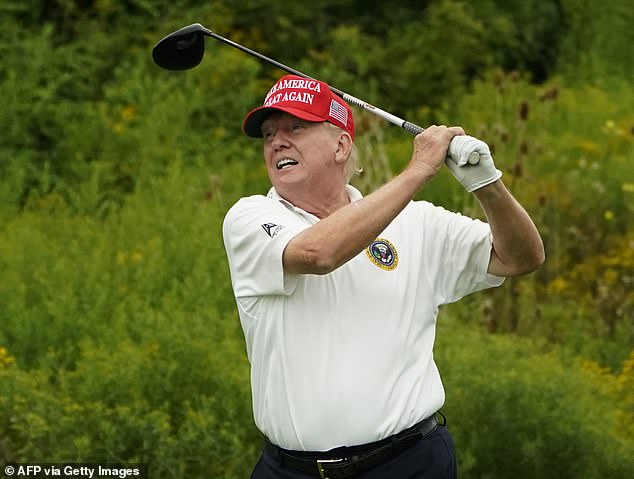Donald Trump’s Golfing Habits While in Office: A Deep Dive
Since Donald Trump’s second term as President of the United States began in January, he has garnered significant attention—not just for his political maneuvers but also for his avid love of golf. According to reports, Trump has spent approximately a quarter of his days at golf courses during this term, sparking conversations about the implications of his golfing lifestyle on taxpayers and his presidential responsibilities.
Trump’s penchant for the links drew criticism during his first term, and it appears that this trend has continued into his second. Current analyses indicate that he has dedicated 37 days out of less than 150 to playing golf, according to the website Did Trump Golf Today, which meticulously tracks his golfing exploits. These numbers not only reflect his commitment to the sport but also raise questions about his role and priorities as President while occupying the White House.
The cost associated with Trump’s frequent golf trips is staggering. Each outing reportedly costs taxpayers around $1.4 million, amounting to a hefty $51.8 million this year alone. Such expenditures have drawn ire from various quarters, who argue that this extravagant spending comes at a time when the nation faces pressing economic challenges. The figure is based on a report by the U.S. Government Accountability Office that documented the expenses incurred from four golf trips during Trump’s first term. In contrast, many Americans may find it difficult to justify such costly habits when balanced against the needs of the populace.
Despite the mounting criticism, Trump continues to assert that he can effectively juggle his golfing schedule with his presidential duties. Over the past several months, he has traveled extensively—from negotiating business deals and investments in Saudi Arabia and Qatar to attending significant events like the funeral of Pope Francis in Italy. His keen ability to maintain a rigorous travel schedule while still dedicating substantial time to golf raises eyebrows among observers who question whether his commitments are appropriately aligned with the responsibilities of the highest office.
In June, Trump participated in both the G7 summit in Canada and is set to attend the NATO summit in the Netherlands. During his second term, the longest stretch Trump has abstained from golf is 11 days, from April 21 to May 1. This current golfing streak highlights a trend where he has only played golf twice in June thus far. Interestingly, if he remains off the course until the upcoming week, he would break his previous record for days without golf in this term.
Trump’s golf outings aren’t merely recreational; they often serve as informal venues for policy discussions. Notably, he has engaged with officials like PGA Tour Commissioner Jay Monahan to discuss the merger with LIV Golf and its implications. Such meetings at the golf course underscore how sports can intertwine with policy-making, creating a unique backdrop for high-stakes dialogues, even while his critics express concerns over his priorities and expenditures.
His golfing sessions have also become personal ventures, nurturing familial bonds—particularly with his eldest grandchild, Kai Trump. Kai, who aims to play collegiate golf at the University of Miami, serves as a reminder of the connection shared through sports, adding a more human element to Trump’s public persona. Furthermore, this bond highlights the complexities of familial relationships often intersecting with political landscapes.
Yet the costs associated with these golfing habits are likely to fuel discontent among critics, particularly as protests over Trump’s immigration policies have erupted in Los Angeles. Many Americans remain engaged in heated discussions about social justice, and Trump’s leisurely outings have become a point of contention against this backdrop of unrest. For instance, members of the Los Angeles Dodgers, who recently visited the White House, have voiced concerns over the political climate, emphasizing a disconnect between Trump’s leisure activities and pressing social issues.
Fortifying this narrative, Dodgers player Kike Hernandez highlighted the emotional toll of ongoing immigration protests in Los Angeles, expressing sadness and frustration over the current socio-political landscape. His comments underscore the broader context of unrest that juxtaposes with Trump’s leisurely golf outings, urging political figures to remain in touch with the struggles of everyday Americans.
With Trump’s second term effectively challenging norms surrounding presidential duties, many are left wondering if the trend of golfing president will continue to resonate and reflect the attitudes of leadership in contemporary America. While enjoying leisure time is a privilege enjoyed by many, balancing that with the demands and responsibilities of governance remains at the forefront of public discourse. As Trump continues his term, it will be interesting to see how these golfing habits evolve and how they ultimately influence not only his presidency but also the public’s perception of it.
As the political landscape remains dynamic, the intersection of sports and governance will continue to evolve, warranting close attention and critical analysis. Whether viewed positively or negatively, Trump’s golfing habits encapsulate significant aspects of his leadership style and priorities, prompting ongoing discussions about the nature of effective governance in the modern age.


